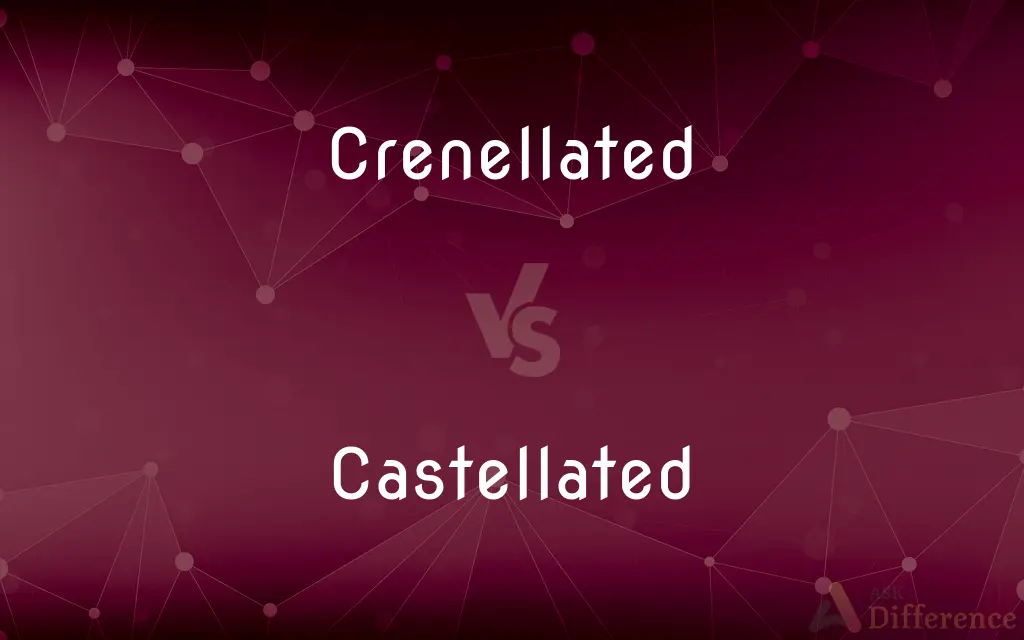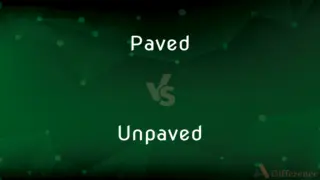Crenellated vs. Castellated — What's the Difference?
By Fiza Rafique & Urooj Arif — Updated on April 3, 2024
Crenellated structures feature battlements for defense, while castellated buildings mimic the style of castles, often for aesthetic purposes.

Difference Between Crenellated and Castellated
Table of Contents
ADVERTISEMENT
Key Differences
Crenellation refers to the architectural feature consisting of alternating high and low sections along the top of a wall, known as merlons and crenels (or embrasures), designed primarily for defense in fortified structures. Castellation, on the other hand, implies the architectural style that incorporates elements resembling a castle, including battlements, but often for stylistic rather than defensive reasons.
Crenellated walls were a practical design in medieval architecture, allowing defenders to take cover behind the merlons while firing arrows or throwing objects through the crenels. Castellated buildings might feature similar designs but are typically found in later periods where such defenses were no longer necessary, serving more as architectural homage to the medieval style.
The intention behind crenellation is rooted in military strategy and the need for protection, a requirement for building permissions historically granted through a royal or feudal license. Conversely, castellation reflects a romantic or nostalgic appeal to the feudal past, evident in country houses and estates built during the Gothic Revival period, where such features were decorative.
While both terms are often used interchangeably due to their visual similarities, the distinction lies in their original purpose and context. Crenellated structures had a clear defensive role in historical fortifications, whereas castellated structures adopted the appearance for aesthetic or symbolic reasons, often without the need for actual defense.
The presence of crenellation or castellation on a building today usually indicates either a preserved historical fortification or a more modern structure designed in the Gothic Revival or similar styles, paying homage to the architectural forms of the past.
ADVERTISEMENT
Comparison Chart
Purpose
Defensive
Aesthetic or symbolic
Design
Alternating merlons and crenels for protection and offense
Mimics castle features, including battlements, for style
Historical Context
Medieval, for practical defense needs
Gothic Revival and later, reflecting nostalgia
Architectural Intent
Strategic and functional in fortifications
Decorative, often on estates or houses
Licensing
Required a royal or feudal license historically
No license needed, as it serves no defensive purpose
Compare with Definitions
Crenellated
Alternating high and low sections (merlons and crenels).
Soldiers used the crenels to attack invaders while remaining protected.
Castellated
Inspired by a fascination with the medieval past.
The 19th-century estate features castellated turrets for a historic feel.
Crenellated
Essential for military defense in historical contexts.
Crenellated towers were strategic points in castle defense.
Castellated
Lacks the strategic defense function of true battlements.
The house's castellated features are purely decorative.
Crenellated
Designed for protection in medieval fortifications.
The castle's crenellated walls provided cover for archers.
Castellated
Reflects a stylistic preference rather than necessity.
The Gothic Revival brought about a resurgence in castellated architecture.
Crenellated
Indicates a structure's role in historical defense strategies.
The ancient fort's crenellated battlements are well-preserved.
Castellated
Emulates the appearance of castles for visual appeal.
The castellated mansion evokes a romanticized medieval era.
Crenellated
Historically required permission to construct.
A royal license was often needed to crenellate a building for defense.
Castellated
Seen in various building types, including schools and homes.
The university's castellated library is a nod to Gothic architecture.
Crenellated
Having battlements.
Castellated
Furnished with turrets and battlements in the style of a castle.
Crenellated
Indented; notched:a crenelated wall.
Castellated
Having a castle.
Crenellated
Simple past tense and past participle of crenellate
Castellated
Castle-like: built or shaped like a castle.
Crenellated
Having crenellations or battlements.
Castellated
(engineering) Having grooves or recesses on an upper face.
Crenellated
Having a series of square indentations.
Castellated
Castled: having or furnished with castles.
Crenellated
Having repeated square indentations like those in a battlement;
A crenelated molding
Castellated
(rare) Housed or kept in a castle.
Crenellated
(of a building) having turrets and battlements in the style of a castle
Castellated
(obsolete) enclosed, when used for fountains, cisterns, &c.
Castellated
Inclosed within a building; as, a fountain or cistern castellated.
Castellated
Furnished with turrets and battlements, like a castle; built in the style of a castle.
Castellated
(of a building) having turrets and battlements in the style of a castle
Common Curiosities
Can modern buildings be crenellated or castellated?
Modern buildings can be castellated for stylistic reasons; true crenellation with a defensive purpose is largely historical.
Did all castles have crenellated walls?
Many castles featured crenellated walls for defense, but not all; the design depended on the castle's strategic importance and location.
Why were crenellations important in medieval architecture?
Crenellations provided a strategic defense mechanism in fortifications, allowing defenders to protect themselves while attacking.
Is permission still required today to crenellate a building?
While historical laws required permission for crenellation, modern buildings styled with castellation do not need such licenses, as these features are decorative.
Are there any functional benefits to castellation today?
Beyond aesthetic appeal and historical homage, there are no practical defense benefits to castellation in contemporary architecture.
Can a building be both crenellated and castellated?
Yes, a building can feature crenellations for historical or aesthetic reasons and be described as castellated if the style aims to replicate medieval castles.
What is the main difference between crenellated and castellated structures?
Crenellated structures are designed for defense with functional battlements, while castellated structures adopt similar features mainly for aesthetic purposes.
What architectural style is known for its castellated buildings?
The Gothic Revival style is known for incorporating castellated elements into its designs.
What materials are used in crenellated and castellated architecture?
Traditionally, stone was the primary material, but modern interpretations may use a variety of materials for stylistic purposes.
Do crenellated and castellated designs influence a building's value?
Such designs can increase a building's aesthetic and historical value, potentially making it more desirable or valuable.
How are crenellated and castellated features maintained?
Preservation efforts focus on maintaining structural integrity and historical accuracy, which may involve restoration projects.
How does the public perceive crenellated vs. castellated buildings?
Crenellated buildings are often seen as authentic historical structures, while castellated buildings are appreciated for their romantic or aesthetic value.
How do crenellated and castellated buildings affect their surroundings?
They can add historical character and visual interest, enhancing the architectural diversity of their surroundings.
What role do crenellated and castellated buildings play in cultural heritage?
They serve as architectural reminders of historical periods, contributing to cultural heritage and educational opportunities.
Can any building be designed with crenellated or castellated features?
While any building can incorporate these features, the design must align with local architectural standards and historical context.
Share Your Discovery

Previous Comparison
Bulk vs. Mass
Next Comparison
Paved vs. UnpavedAuthor Spotlight
Written by
Fiza RafiqueFiza Rafique is a skilled content writer at AskDifference.com, where she meticulously refines and enhances written pieces. Drawing from her vast editorial expertise, Fiza ensures clarity, accuracy, and precision in every article. Passionate about language, she continually seeks to elevate the quality of content for readers worldwide.
Co-written by
Urooj ArifUrooj is a skilled content writer at Ask Difference, known for her exceptional ability to simplify complex topics into engaging and informative content. With a passion for research and a flair for clear, concise writing, she consistently delivers articles that resonate with our diverse audience.
















































